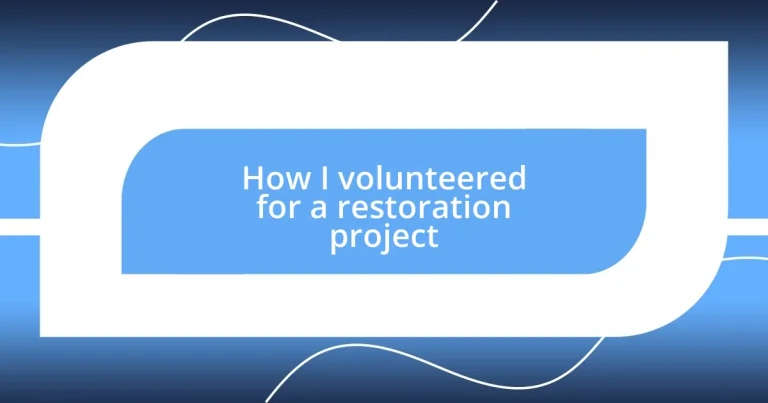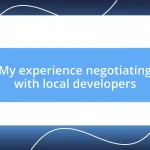Key takeaways:
- Choosing a restoration project should align with personal passions and values, enhancing the volunteer experience.
- Preparation—both physical and mental—along with adaptability is crucial for successfully navigating challenges in volunteer work.
- Building connections with fellow volunteers fosters a sense of community, making the experience more rewarding and enjoyable.

Choosing a Restoration Project
When I began my search for a restoration project, I found myself reflecting on what truly motivated me. Was it the desire to preserve local history, or perhaps to connect with nature? I remember standing at an old, forgotten site, visualizing how vibrant it once was and feeling that tug to be part of its revival.
Choosing the right project is like picking a puzzle piece that fits your passion and skills. For me, it wasn’t just about any restoration; it had to resonate with my values and interests. I often ask myself, “What impact do I want my efforts to have?” This thought process helped guide me toward initiatives that genuinely sparked my enthusiasm, making each volunteering day feel fulfilling rather than like a chore.
As I sifted through options, I realized the importance of local communities in these projects. Engaging with people who share a common goal adds depth to the experience. I vividly recall sharing stories with fellow volunteers over coffee breaks, discovering that we were not just restoring a structure but rekindling friendships and a sense of belonging in the community. Isn’t it incredible how a single project can weave connections among people?

Finding Volunteer Opportunities
Finding the right volunteer opportunity requires some digging, but it’s often easier than I expected. I turned to online platforms that specialize in connecting volunteers with local organizations. During my search, I stumbled upon a treasure trove of projects just waiting for passionate people. The joy of seeing a cause that resonated with me was exhilarating!
Here are some effective ways to discover those golden opportunities:
- Local Nonprofits: Visit their websites or social media pages for upcoming projects.
- Volunteer Websites: Platforms like VolunteerMatch or Idealist can help you filter opportunities based on your interests.
- Community Centers: Often host events or can connect you with ongoing restoration projects.
- Social Media Groups: Join local community groups where volunteers share opportunities.
- Word of Mouth: Talking to friends or family might uncover hidden gems.
I remember the thrill when I found an open call for volunteers at a historic garden near my home. It felt like fate. Connecting with that community not only helped preserve our local history, but it ignited a spark within me, reminding me how fulfilling it is to contribute to something bigger than myself.

Preparing for Volunteer Work
To successfully prepare for volunteer work, it’s essential to gather the right tools and mindset. I remember when I first volunteered for a restoration project, I made a checklist of supplies like gloves, sturdy shoes, and sun protection. This simple act helped me feel equipped and ready to dive in. It’s amazing how being prepared can shift your mindset from uncertainty to enthusiasm!
Mental preparation is equally important. I often spend time reflecting on what the experience means to me. Before my last project, I took a quiet moment with my thoughts, visualizing what I would accomplish. Asking myself questions like, “What skills do I want to develop?” made me feel more connected to the task ahead. It’s such a powerful practice—building that mental muscle along with the physical tools.
Finally, I always encourage having an open heart and mind. Volunteering can sometimes lead to unexpected challenges, like weather changes or technical setbacks. I vividly recall a day when heavy rain disrupted our plans, forcing us to adapt. Instead of feeling discouraged, those moments led to laughter, bonding, and creativity among the team. Embracing spontaneity can truly enrich the volunteer experience!
| Preparation Aspect | Description |
|---|---|
| Physical Supplies | Gather necessary gear like gloves, sturdy footwear, and sun protection. |
| Mental Readiness | Reflect on personal motivations and visualize the goals of the project. |
| Emotional Openness | Stay flexible and embrace the unexpected moments during the experience. |

Essential Skills for Volunteers
Volunteering in a restoration project requires a unique blend of skills. One essential skill I’ve found invaluable is teamwork. When I participated in a restoration initiative, I realized that collaborating with others not only enhances the efficiency of the work but also enriches the experience itself. Have you ever noticed how shared goals can foster bonds? I certainly did, especially as we tackled challenging tasks together, transforming hard labor into moments of laughter and camaraderie.
Communication is another critical skill for volunteers. Clear and open dialogue among team members ensures everyone is on the same page. I vividly remember a time when misunderstandings about tasks led to a bit of chaos on-site. It was a simple reminder of how easy it is to misinterpret intentions. Since then, I’ve made it a point to double-check my understanding and encourage others to speak up. Isn’t it fascinating how a little clarification can turn potential frustration into collaboration?
Lastly, adaptability can make all the difference in a volunteer environment. Projects often don’t go as planned—just think about the unpredictable weather or resource shortages. I once faced wrenches being thrown into our plans, and instead of frustration, we ended up brainstorming creative solutions. I found this flexibility not only made the task at hand manageable but also deepened our bond as a team. Embracing change can transform hurdles into unique experiences—how have you navigated unexpected moments in your volunteer work?

My Experience on the Project
During my time on the restoration project, I discovered just how rewarding hard work can be. On one particularly long day, we were tasked with clearing an overgrown area. As fatigue set in, I felt my motivation wavering. But looking around at my teammates, sharing jokes and pushing through together, sparked something in me. It’s incredible how collective energy can uplift you, making even the most daunting tasks enjoyable.
I also experienced firsthand how important it is to celebrate small victories. I vividly remember the moment we completed a challenging section of the restoration. We paused, high-fiving and cheering, even if it was just a small accomplishment in a much larger task. This moment taught me that recognizing our achievements, no matter how minor, helps build a sense of community. Isn’t it amazing how these shared feelings can create lasting bonds among volunteers?
Another impactful experience was learning to appreciate the details. While repairing an old fence, I noticed the intricate craftsmanship that had been overlooked for years. I found myself fascinated by the beauty in the imperfections. It made me wonder—how often do we miss the subtle details in our everyday lives? That moment reminded me to approach every project, and indeed life, with a sense of curiosity and appreciation. I left the site not just with a sense of fulfillment but with a renewed perspective on beauty—what about you? How do you find joy in the details of your own experiences?

Challenges Faced During Volunteering
Volunteering in restoration projects isn’t without hurdles. One of the biggest challenges I faced was physical fatigue. There were days when muscle soreness felt like an unwelcome companion, especially after endless hours of lifting and digging. It made me question my limits and wonder if I had the stamina to keep pushing forward. Have you ever felt like giving up, only to surprise yourself with what you could achieve?
Another unexpected hurdle was navigating the emotional ups and downs. For instance, after a particularly grueling day, I found myself feeling disheartened when progress seemed slow. I remember seeing a massive pile of debris that looked almost insurmountable. But as we chipped away at it, I learned the significance of perseverance. It was in those moments of doubt that I truly appreciated the strength of our collective resolve. How often do we surprise ourselves by rising above our challenges?
Additionally, there were technical difficulties that arose, too. During one project, we encountered an issue with mismatched materials that derailed our progress. I felt a wave of frustration wash over me, thinking, “Will we ever finish?” However, it turned out to be a valuable lesson in problem-solving. We brainstormed alternatives and ended up finding solutions that truly showcased our creativity. Isn’t it interesting how obstacles can sometimes lead to unexpected breakthroughs?

Tips for Future Volunteers
When volunteering on a restoration project, I found that preparation is key. Arriving with the right gear—not just sturdy boots but also gloves and hydration packs—can make a world of difference. Have you ever tried to work while uncomfortable? It can be a real drain on your enthusiasm, so investing time in gearing up properly helps you focus on the task.
Don’t underestimate the power of asking questions. During my time in the project, there were moments when I felt out of my depth, not knowing how to tackle a specific task. Each time I took the initiative to ask for help, I was met with encouragement and guidance. This experience taught me that vulnerability is a strength. How often do we miss out on learning simply because we hesitate to reach out for support?
Lastly, I encourage future volunteers to embrace the social aspect of these projects. Connecting with fellow volunteers created a sense of camaraderie that made the work much more enjoyable. I remember bonding with a teammate over shared stories during lunch breaks, which made me look forward to each workday. It’s amazing how these interactions can transform a tough day into a delightful experience. Have you ever noticed how community can boost morale in the face of challenges?














